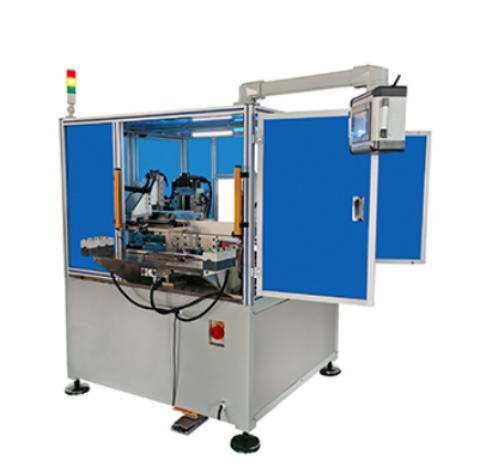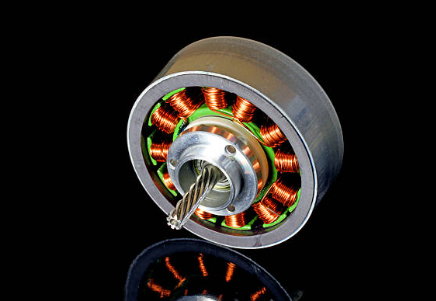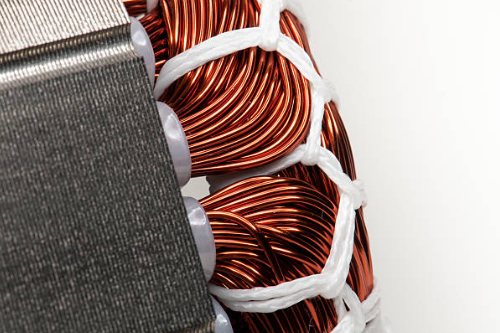Stator winding machines span a range from simple manual coil formers to high speed automated winders.
Types of stator winding machines include basic hand operated or semi-automatic rigs, as well as fully
automated systems. Manual and semi-automatic machines typically feature a single winding head; operators
form coils on the machine and insert them by hand. By contrast, fully automatic stator winding machines
integrate multiple servo-driven axes to wind, cut, and even insert coils into stator slots without human intervention.
Key categories include:
1. Manual/Semi-Automatic Machines: Entry-level winding tables or single-head machines that require human
loading of the stator and transfer of finished coils. They are simple and low-cost but rely on operator skill
and have lower throughput.
2. Fully Automatic Machines: Multi-axis, servo-controlled systems that perform entire winding cycles automatically.
These machines handle wire feeding, tension control, coil forming, and often incorporate auto-insertion of coils
into the stator. They offer high repeatability and speed for large-volume production.
3. Specialized Configurations: Some machines are tailored to specific winding styles (e.g. multi-strand windings,
flat-wire or hairpin coils) to maximize slot fill or suit unique stator designs. These may use special tooling or
multiple winding heads to achieve complex coil arrangements.
4. Each type of winding machine serves different needs. Manual or semi-auto winders suit low-volume or diverse
product lines, while automatic stator winding machines are ideal for mass production of identical stators with
minimal manual labor. (Hub motor stators, discussed below, often require their own specialized machines.)

2. Automatic Stator Winding Machines
Modern automatic stator winding machines use advanced servo drives and CNC controls to deliver
precise, repeatable coils. Operators program the machine via an HMI (human-machine interface),
specifying coil turns, taps, and winding patterns. During operation, the machine’s computer controls
each axis for exact speed and tension, ensuring consistent copper placement and high slot fill. Many
systems also include automated coil insertion devices (needles, fingers, or magnets) that place wound
coils into the stator slots immediately after winding, eliminating manual handling.
Key features of automatic stator winders include:
1. Servo-Controlled Axes: Each movement (wire feed, head rotation, carousel indexing) is driven by a servo motor.
This provides variable speed, smooth motion, and fine tension control, which is crucial for tight coils and high
slot fill factor.
2. Programmable Winding: Machine programs store parameters like number of turns, skipping patterns, and
multi-layer arrangements. Changeovers to new stator models simply require loading a different program and
swapping minimal tooling.
3. Integrated Coil Insertion: Automated insertion stages push or drop coils into the stator's slots in a single step
after winding. This feature improves cycle time and ensures uniform coil placement. Some machines can also
automatically cut wire tails and trim ends.
4. Advanced Controls and Monitoring: Built in diagnostics track production counts, detect wire breaks, and can
measure coil resistance or weight for quality assurance. Touchscreen interfaces allow easy setup of winding
sequences and adjustment of parameters on the fly.
5. Overall, fully automatic stator winding machines dramatically increase throughput and consistency. They are the
industry standard for high-volume motor manufacturing, offering rapid winding cycles (often hundreds of RPM) and
minimal scrap due to precise coil insertion and tension management.

3. Hub Motor Stator Winding Machines
Hub motor stators present unique challenges due to their compact, unusual geometry. In e-bike or
wheel-hub motors, the stator may be inside or outside the rotor, and coils often have large turn counts
with one or two turns per coil. A hub motor stator winding machine is specifically designed to accommodate
these differences. Such machines usually feature a horizontal winding station (if the stator is inside the rotor)
or a special fixture to hold short, wide stator cores. Key aspects of hub motor winders include:
1. Custom Coil Heads: Hub motor winders may use different head designs (such as linear bobbin insertion
or ring-winding tools) to fit coils into the small stator space. The winding head might move axially to loop
the wire around each pole in one or two turns, which is common for hub motor coils.
2. High Slot Fill Capability: Many hub motors use multi-strand wire or parallel winding to improve slot fill factor
in the limited slot area. The machines support these multi-wire techniques and ensure uniform filling of the
stator slots.
3. Compact Work Envelope: These winders are built with a smaller footprint or with gates to load and unload
hub stator assemblies. The automation level (servo drives, PLC control) remains high to maintain consistent
winding tension and placement.
4. For example, a hub motor stator winder might automatically index each pole position and wind a multi-strand
coil in a single step, then move to the next pole. Despite their specialized purpose, they still leverage the same
technologies (servo drives, programmable HMI) as general winding machines. In practice, a hub motor winding
machine combines the advantages of automation (speed and precision) with tooling adapted for the hub motor's
short axial length and often thicker wires or coil bars.
4. Key Technical Considerations
When evaluating stator winding machines (manual or automatic), several technical factors significantly
impact performance:
1. Servo Drive Systems: Modern machines use servo drives rather than mechanical cams. Servo control
allows electronic adjustment of winding speed and tension for different stator sizes, and it provides
smoother acceleration. This is especially important for multi-strand or flat-wire windings, where precise
tension prevents wire breakage and maximizes slot fill factor.
2. Slot Fill Factor: The ability to pack copper into the stator slots affects motor efficiency. Winding machines
that can handle multiple parallel strands, or even form hairpin/flat-wire coils, tend to achieve higher slot fill.
When selecting a machine, consider if it supports the conductor type and bundling needed for your fill goals.
3. Coil Insertion Mechanisms: Look at how coils are placed into the stator after winding. Automatic insertion
(using prongs, vacuum, or simple gravity drop) reduces manual labor and improves consistency. Some
machines offer a one-step insertion for straight-slot coils, while others use multi-step pivoting arms for
complex geometries. A robust insertion system is key to high throughput and avoiding damage to delicate coils.
l 4. simultaneously. More axes increase throughput proportionally. However, multi-head machines require
synchronous servo control on each axis. Also evaluate how many wire feeders or spool holders are available
if you plan multi-strand winding.
5. Tooling and Changeover: Check how tooling changes are handled. Rapid-change fixtures and programmable
offset adjustments save time when switching between different stator diameters or pole counts. Some advanced
machines can auto-adjust winding parameters from a saved recipe, minimizing downtime.
6. These factors (servo-driven axes, slot fill capability, coil insertion design) determine how well a stator winding
machine will meet your technical requirements. In practice, balance the machine’s capabilities with the
complexity of your coils and the precision your motor demands.

5. Stator Winding Machine Selection Strategies
Choosing the right winding machine involves matching machine capabilities to product needs and
production goals. Important selection criteria include:
1. Production Volume and Flexibility: For high-volume, dedicated motor lines, a fully automatic multi-head
machine delivers the fastest cycle times and lowest labor cost per unit. For smaller runs or multiple motor
models, a programmable CNC winder or dual-purpose machine may be better, as it allows quicker changeovers
and handles varied coil geometries.
2. Stator and Coil Design: Evaluate the stator's slot count, coil shape, and wire size. Specialty coils (e.g. pinned
coils, hairpin bars, or single-turn coils) require compatible winding heads. Make sure the machine's winding
head type (round-wire bobbin, hairpin feeder, etc.) and fixture system can accommodate your stator's dimensions
and coil structure.
3. Slot Fill and Performance Targets: If maximizing slot fill is a priority (for high-torque motors), choose a machine
that supports multi-wire parallel winding or flat-wire handling. Higher slot fill often means using two or more
thinner wires instead of one thick wire, so confirm that the machine can guide multiple conductors and maintain
tension on each.
4. Automation and Integration: Consider how the winder will fit into your production line. Some machines offer
robotic part loading, vision inspection, or interface with MES systems for traceability. Advanced automation
(like automatic stator transfer feeders) can boost overall output but adds cost and complexity. Plan for any
needed peripheral equipment (coil transfer loaders, stator indexing tables) that complement the winding
machine.
5. Budget and Service: Balance initial cost against long-term value. A higher-end machine costs more upfront
but may pay off in reduced labor and scrap. Also assess the supplier's support: training, maintenance, spare
parts, and software updates are crucial. Ask about warranties and whether the machine can be upgraded
(for example, adding a second winding head or Vision QC system later).
 中文版
中文版 English
English



